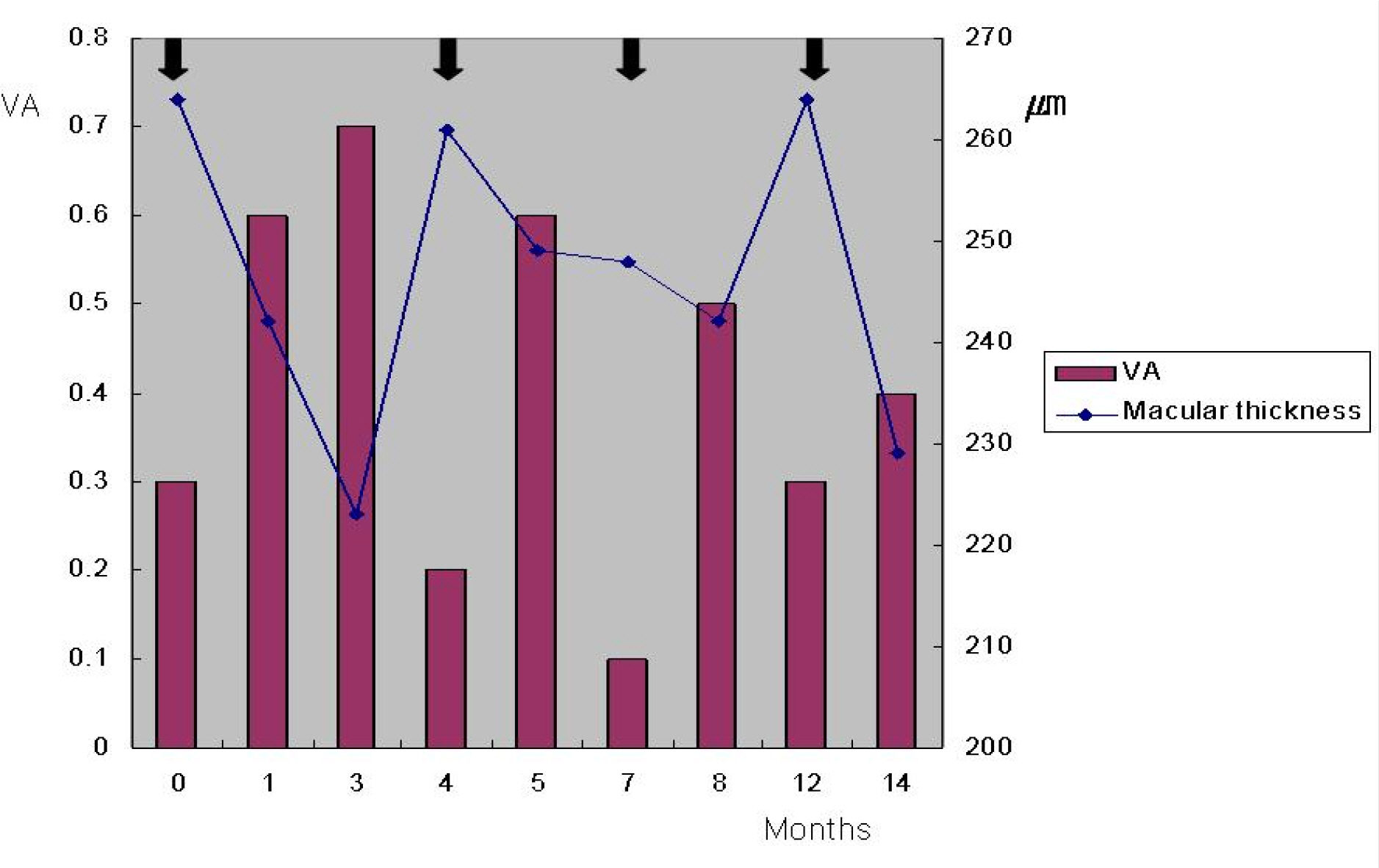J Korean Ophthalmol Soc.
2008 Apr;49(4):685-690. 10.3341/jkos.2008.49.4.685.
A Case of Photodynamic Therapy of Juxtafoveal Choroidal Neovascularization in Angioid Streaks
- Affiliations
-
- 1Department of Ophthalmology Gyeong Sang National University, Colleage of Medicine, Gyeongnam, Korea. in0@netian.com
- 2Gyeong Sang Institute of Health Science, Gyeong Sang National University, Gyeongnam, Korea.
- KMID: 2211504
- DOI: http://doi.org/10.3341/jkos.2008.49.4.685
Abstract
-
PURPOSE: To report a case of verteporfin photodynamic therapy (PDT) for juxtafoveal choroidal neovascularization (CNV) secondary to angioid streaks.
CASE SUMMARY
An 54-year-old male presented with metamorphopsia of the right eye. It was diagnosed as juxtafoveal CNV secondary to angioid streaks and treated with verteporfin PDT-Best corrected visual acuity (BCVA) and macular thickness by optical coherence tomography (OCT) were measured. Over 14 month follow-up period, baseline BCVA was 0.3 and it increased to 0.4 by the final examination, while macular thickness decreased from 264 micrometer to 229 micrometer. No side effects of PDT were noted.
CONCLUSIONS
Verteporfin PDT for CNV-associated with angioid streaks does not appear to significantly alter the course of the disease undergoing enlargement and disciform transformation of the neovascular process. However, we expected that the actual clinical findings improved during short term follow-up. The severity of symptoms of CNV-associated with angioid streaks in a single patient varies over time, so long-term follow-up and careful examination is needed.
MeSH Terms
Figure
Reference
-
References
1. Piro RA, Scheraga D, Fine SL. Angioid streaks: Natural history and visual prognosis. Fine SL, Owen SL, editors. 1st ed.Management of retinal vascular and macular disorders. Baltimore: Williams & Wilkins;1983. v. 1. chap.p. 21.2. Clarkson JG, Altman RD. Angioid streaks. Surv Ophthalmol. 1982; 26:235–46.
Article3. Singerman LJ, Hatem G. Laser treatment of choroidal neovascular membranes in angioid streaks. Retina. 1981; 1:75–83.
Article4. Macular photocoagulation study group. Laser photocoagulation for juxtafoveal choroidal neovascularization. Five‐ year results from randomized clinical trials. Arch Ophthalmol. 1994; 112:500–9.5. Gelisken O, Hendrikse F, Deutman AF. A long‐ term follow-up study of laser coagulation of neovascular membranes in angioid streaks. Am J Ophthalmol. 1988; 105:299–303.6. Treatment of age‐ related macular degeneration with photodynamic therapy (TAP) study group. Photodynamic therapy with subfoveal choroidal neovascularization in age-related macular degeneration with verteporfin: one‐ year results of 2 randomized clinical trials-TAP report. Arch Ophthalmol. 1999; 117:1329–45.7. Verteporfin in photodynamic therapy study group. Photodynamic therapy of subfoveal choroidal neovascularization in pathologic myopia with verteporfin: 1‐ year results of a randomized clinical trials-VIP report no 1. Ophthalmology. 2001; 108:841–52.8. Bressler NM, Bressler SB, Fine SL. Age-related macular degeneration. Surv Ophthalmol. 1988; 102:374–413.
Article9. Mansour AM. Systemic associations of angioid streaks. Int Ophthalmol Clin. 1991; 31:61–8.
Article10. Sickenberg M, Schmidt‐ Erfurth U, Miller JW, et al. A preliminary study of photodynamic therapy using verteporfin for choroidal neovascularization in pathologic myopia, ocular histoplasmosis syndrome, angioid streaks, and idiopathic causes. Arch Ophthalmol. 2000; 117:327–36.
Article11. Karacorlu M, Karacorlu S, Ozdemir H, Mat C. Photodynamic therapy with verteporfin for choroidal neovascularization in patients with angioid streaks. Am J Ophthalmol. 2002; 134:360–6.
Article12. Shaikh S, Ruby AJ, Williams GA. Photodynamic therapy using verteporfin for choroidal neovascularization in angioid streaks. Am J Ophthalmol. 2003; 135:1–6.
Article13. Browning AC, Chung AK, Ghanchi F, et al. Verteporfin photodynamic therapy of choroidal neovascularization in angioid streaks: One year results of a prospective case series. Ophthalmology. 2005; 112:1227–31.14. Blair MP, Apte RS, Miskala PH, et al. Retrospective case series of juxtafoveal choroidal neovascularization treated with photodynamic therapy with verteporfin. Retina. 2004; 24:501–6.
Article15. Lim JI, Bressler NM, Marsh MJ, Bressler SB. Laser treatment of choroidal neovascularization in patients with angioid streaks. Am J Ophthalmol. 1993; 116:414–23.
Article16. Ladas ID, Georgalas I, Rouvas AA, et al. Photodynamic therapy with verteporfin of choroidal neovascularization in angioid streaks: Conventional versus early retreatment. Eur J Ophthalmol. 2005; 15:69–73.
Article
- Full Text Links
- Actions
-
Cited
- CITED
-
- Close
- Share
- Similar articles
-
- Photodynamic Therapy for Choroidal Neovascularization in Angioid Streaks
- Photodynamic Therapy With Verteporfin for Choroidal Neovascularization in Patients with Angioid Streaks
- A Case of Intravitreal Bevacizumab Injection for the Treatment of Choroidal Neovascularization in Angioid Streaks
- Photodynamic Therapy For Recurred Subfoveal Choroidal Neovascularization After Argon-Laser Photocoagulation
- Fluorescein Study of Angioid Streaks with Pseudoxanthoma Elasticum




